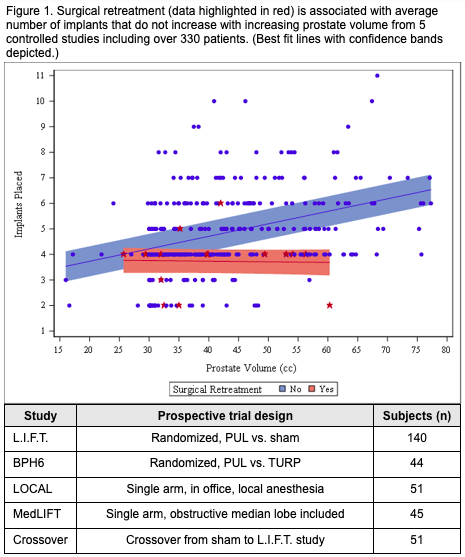Back
Introduction: Durability is increasingly the focus of discussions on BPH treatment outcomes. In the present analysis, we examine how baseline and procedural variables underlie treatment durability in over 330 PUL subjects treated in a controlled trial setting.
Methods: Logistic regression analysis was built aggregating patients from five PUL controlled studies. ‘Successful durability’ was defined as a subject that did not undergo surgical retreatment for BPH (+/- being BPH medication free) at 1- and 5-years post-PUL. Covariates used in the model included age, race, BMI, prostate volume, proxies of BPH disease severity (IPSS, QoL, Qmax, PVR, PSA), medical history (i.e., history of diabetes, retention, UTI), and procedural characteristics (number of implants, implants per prostate volume).
Results: In these controlled studies, PUL was durable in most subjects at 1 and 5 years. With increasing prostate volume, increasing numbers of implants were placed. Average number of implants placed was 4.8 (SD 1.6). No patient who received seven or more implants required BPH surgical retreatment during follow up. 1-year durability: Baseline IPSS total score did not impact durability, although increased hesitancy/straining at baseline (IPSS Q6) predicted surgical or medical failure. In addition, fewer overall implants placed (=4 vs >4) as well as lower implant-to-prostate volume ratio (=1 vs >1 implant/10cc volume) predisposed subjects to surgical retreatment or return to medication. 5-year durability: The symptom of incomplete emptying (high IPSS Q1) at baseline impacted surgical retreatment rate which was 13.7% at 5 years. At baseline, high quality of life score (high dissatisfaction), high IPSS total scores (elevated symptoms), and high IPSS obstructive domain scores (i.e., incomplete emptying Q1, intermittency Q3, weak stream Q5) predicted retreatment with either surgery or medication.
Conclusions: Lack of PUL durability at 1 year is associated with undertreatment (=4 implants placed). In those patients who successfully avoid surgical retreatment, implant density is higher (>1 implant/10cc volume). Durability at 5 years is primarily affected by poor IPSS obstructive symptoms at baseline. SOURCE OF
Funding: Teleflex, Inc.

Podium Session
Session: PD41: Benign Prostatic Hyperplasia: Surgical Therapy & New Technology V
PD41-06: Pooled analysis of 330+ subjects treated with the Prostatic Urethral Lift (PUL) reveals undertreatment impacts durability
Monday, May 1, 2023
7:50 AM – 8:00 AM CST
Location: S502
.jpg)
Claus Georg Roehrborn, MD (he/him/his)
Department Chair
UT Southwestern Medical Center
Podium Presenter(s)
Introduction: Durability is increasingly the focus of discussions on BPH treatment outcomes. In the present analysis, we examine how baseline and procedural variables underlie treatment durability in over 330 PUL subjects treated in a controlled trial setting.
Methods: Logistic regression analysis was built aggregating patients from five PUL controlled studies. ‘Successful durability’ was defined as a subject that did not undergo surgical retreatment for BPH (+/- being BPH medication free) at 1- and 5-years post-PUL. Covariates used in the model included age, race, BMI, prostate volume, proxies of BPH disease severity (IPSS, QoL, Qmax, PVR, PSA), medical history (i.e., history of diabetes, retention, UTI), and procedural characteristics (number of implants, implants per prostate volume).
Results: In these controlled studies, PUL was durable in most subjects at 1 and 5 years. With increasing prostate volume, increasing numbers of implants were placed. Average number of implants placed was 4.8 (SD 1.6). No patient who received seven or more implants required BPH surgical retreatment during follow up. 1-year durability: Baseline IPSS total score did not impact durability, although increased hesitancy/straining at baseline (IPSS Q6) predicted surgical or medical failure. In addition, fewer overall implants placed (=4 vs >4) as well as lower implant-to-prostate volume ratio (=1 vs >1 implant/10cc volume) predisposed subjects to surgical retreatment or return to medication. 5-year durability: The symptom of incomplete emptying (high IPSS Q1) at baseline impacted surgical retreatment rate which was 13.7% at 5 years. At baseline, high quality of life score (high dissatisfaction), high IPSS total scores (elevated symptoms), and high IPSS obstructive domain scores (i.e., incomplete emptying Q1, intermittency Q3, weak stream Q5) predicted retreatment with either surgery or medication.
Conclusions: Lack of PUL durability at 1 year is associated with undertreatment (=4 implants placed). In those patients who successfully avoid surgical retreatment, implant density is higher (>1 implant/10cc volume). Durability at 5 years is primarily affected by poor IPSS obstructive symptoms at baseline. SOURCE OF
Funding: Teleflex, Inc.

